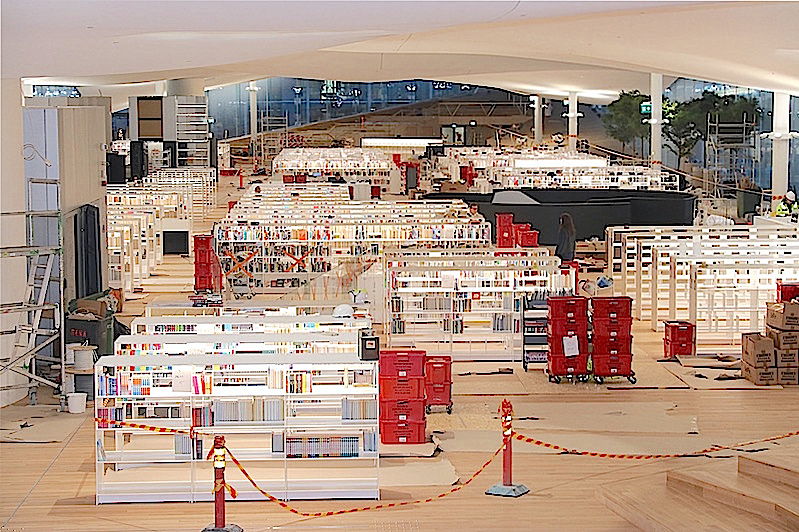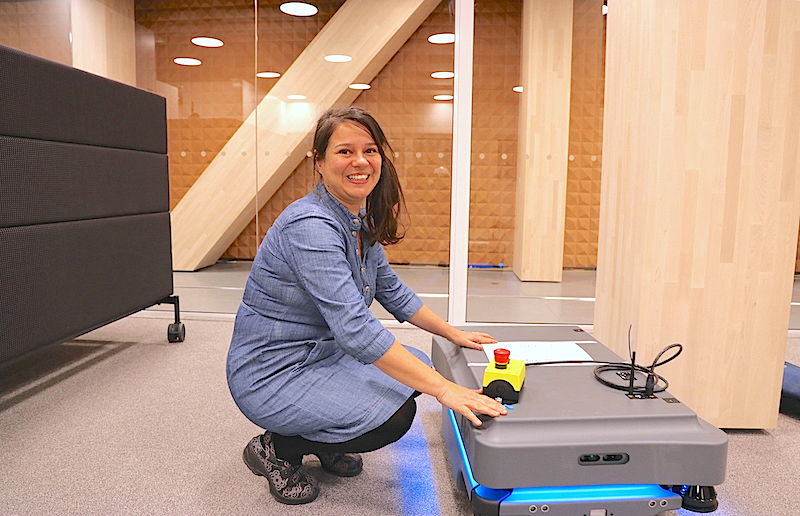Oodi has come alive. The library’s more than 50 employees have taken over the building, from the basement to the Book Heaven, in all the spaces where this is already possible. The staff’s recent weeks have been spent familiarising themselves with the building, installing the machinery and learning how it works and, most of all, shelfing the books. Librarians Suvi Pietilä and Siina Tiuranemi alphabetised novels and shelved them on the new, Italian shelves in the Book Heaven in late November.

The Book Heaven reaches from the southern end of the third floor to its northern end. The selection has a total of 100,000 works, of which about 70,000 are available on the shelves. Newspapers and magazines can also be found here. Oodi’s opening hours will be easy to remember by using the following rule of thumb: eight-ten-eight; on weekdays the library is open from eight in the morning to ten in the evening and on weekends from 10 am to 8 pm.

A visitor can dive into the world of stories and knowledge in special ‘oasis’ resting places. There are nine of these oases in the Book Heaven, offering wanderers a resting place in the shade of an olive tree. The Bucida bucera trees are real, living trees, known by the name of black olive tree. They are native to Mexico and the Caribbean region, for example. The trees were first placed on the western side, where they waited to be moved to their final locations.
Positive customer experiences are the goal
Satisfied staff members are sitting in the staff premises on the second floor. The new workstations and pieces of furniture feel comfortable.

The staff have been divided into teams. Librarian Leena Eskelinen (front left) and informatician Niina Holm work in the ‘content’ team. Project manager Romeo Pulli and librarian Harri Annala represent the ‘facilities and inclusiveness’ team. The job description of special library assistant Nadia Lund-Iivonen (right), who is part of the customer experience team, includes considering customers’ feelings and thoughts as they visit Oodi.

“The customer experience team is responsible for ensuring a pleasant experience of the building and its services for visitors. It is important that the customers can easily find the different locations, services, facilities and devices and have a positive experience of them,” Nadia Lund-Iivonen explains.
Recently, the staff members have familiarised themselves with features such as the automatic guided vehicles that transport boxes of materials between the basement and the Book Heaven.
Craft, print, carve, sew
Oodi represents the maker culture. It provides facilities, devices and guidance for learning various skills and supports different interests and hobbies.

“Oodi is not only a place for culture consumption, but also for making. Here, customers can make anything from music to jewellery and graphics,” says ICT specialist Urpo Nylander, presenting the devices available in the urban workshop.
“The urban workshop, which used to be located in Library 10 and Lasipalatsi, will move to Oodi, larger and improved. The customers can use, for example, a laser cutter, 3D and laser printers and a UV printer. The staff will get the customers started and various training sessions will also become available.”
The UV printer allows users to print on a wooden surface, for example, while the laser cutter is able to cut different materials. A customer could make things such as tools for themselves or replacement parts for different items. If the refrigerator handle at their home has broken down, they can use the 3D printer to make a new one. The 3D milling cutter, on the other hand, allows users to process metals, for example for jewellery making, and the carver can be used to add some character to them.

If a customer needs to shorten their trouser legs or spruce up their shirt, they can come to Oodi to sew and embroider their clothes. There is even an overlocker. Additionally, the floor has console games and eight graphics workstations for editing images and videos. The second floor will be closed right after the opening for installing the devices and opens on the 28th of December.

Event venue Kuutio (The Cube) is one of Oodi’s special features. The room, surrounded by milk glass walls, represents the most advanced screen technology. Two of the walls can be changed into touch screens.
“There are 256 simultaneous contact points on the screen surface, so about twenty people can use the display at the same time. The intention is that Aalto University, for example, will use the room as a showroom for student projects,” Urpo Nylander says.
Oodi chosen as the Steel Structure of the Year
Finnish Constructional Steelwork Association TRY gave Oodi the award for the Steel Structure of the Year in November. This award went jointly to ALA Architects; Ramboll Finland (structural design); the client, i.e. the City of Helsinki; YIT Rakennus Oy (project management constructor); and Normek Oy, which manufactured the building’s complex steel frame.

The award was accepted by (from left to right) Senior Site Manager Tero Seppänen and Project Manager Jorma Kontturi of YIT Rakennus; the Director of City of Helsinki’s Urban Environment Division Jouko Snellman; Architects Jussi Vuori, Juho Grönholm, Samuli Woolston and Niklas Mahlberg (head designer of the site) from ALA Architects; Senior Structural Designer Tapio Aho from Ramboll Finland; Managing Director Pasi Parkkinen from Normek Oy, who also acted as Normek’s project manager on the site; and Steel Structure Designer Simon De Neumann from Ramboll Finland. Photo: Sanna Liimatainen

The award honoured the insightful and skilful steel structures of Oodi, which enable its language of form. These steel structures are best seen on the second floor: One of the two steel arches carrying the building curves above the seating stairs. The floor also features many steel pillars clad with birch veneer.
A valuable building and a landmark
Senior site manager Tero Seppänen from project management contractor YIT says that these final moments in the construction of Oodi make him feel nostalgic. He believes that he has built the landmark of his career.

“Oodi is a valuable building on a valuable plot and it is like a work of art. I will probably not work on any other sites as central as this. Finding the correct project parties for each stage was the most challenging job. We have been able to keep to the schedule, because all the different parties have been in the same boat and have kept the goals clear in their minds. Our three keywords have been cooperation, cooperation and cooperation. The project parties have focused on solving different matters, and the feeling between the client, designers and constructors has remained positive during the entire project,” Seppänen says gratefully.
